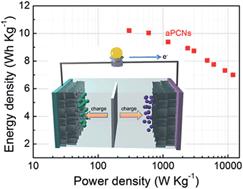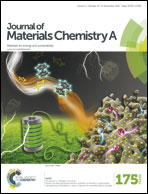Nanospace-confined synthesis of oriented porous carbon nanosheets for high-performance electrical double layer capacitors†
Abstract
Two-dimensional (2D) carbon nanosheets have emerged as an attractive candidate for electrical double layer capacitors (EDLCs) due to their large specific surface area, good electrical conductivity and high charge mobility. However, the easy aggregation nature of nanosheets hinders rapid transport of electrolyte ions, reducing the ion-accessible area and restricting the ion transportation. Herein, we propose a template strategy for preparing three-dimensional (3D) porous carbon nanosheets (PCNs) with an oriented and interconnected nanostructure. Zinc layered hydroxide nitrate is used as a layered template and provides a nanospace to confine the carbonization process of the organic carbon precursor (gallic acid). The unique nanostructure and large surface area of chemically activated PCNs (aPCNs) significantly shorten the ion transport length in low dimensions and improve the electrolyte wettability and ion accessible surface area for charge storage. The aPCNs exhibit excellent performance as demonstrated by their large specific capacitance (327 F g−1 at a current density of 0.5 A g−1), superior rate capability (retaining 60.2% at 20 A g−1) and stable cyclability. In particular, the assembled symmetric device based on aPCNs delivers an energy density as high as 10.2 W h kg−1 at a power density of 301 W kg−1.


 Please wait while we load your content...
Please wait while we load your content...